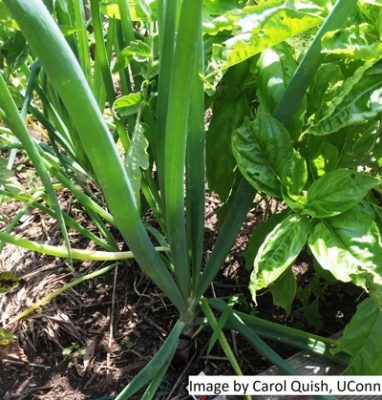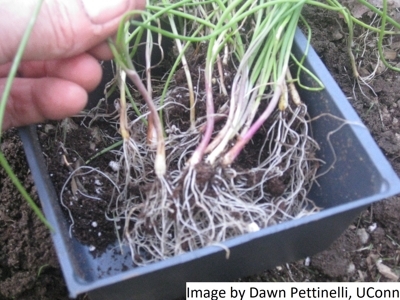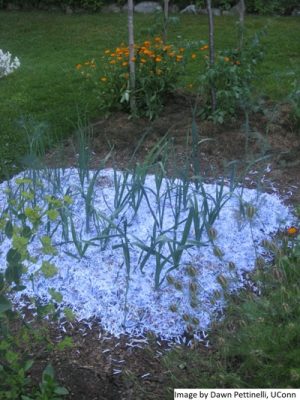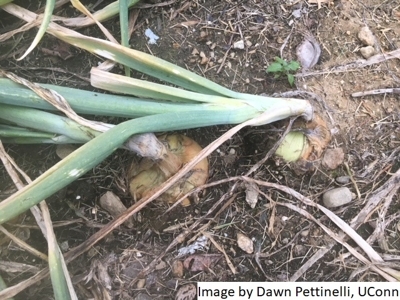Onions
Allium cepa
Onions are a member of the genus Allium along with the closely-related chives, garlic, leeks, scallions, and shallots. They are easy to grow, cool season vegetables. Onion plants are biennial but are usually grown as an annual in Connecticut. Allium cepa has been cultivated for over 7,000 years throughout the world and is grown for its white, red, or yellow edible bulbs.

Soil Requirements
Alliums can be particular about soil conditions. They prefer an almost neutral (6.5 to 6.8 pH), sandy, well-drained soil with moderate to high levels of organic matter. Onions are heavy feeders. Without a soil test, incorporate 2 ½ to 3 pounds of 10-10-10 fertilizer (or the natural/organic equivalent) for every 100 square feet of garden area before planting along with 3 to 4 bushels of leaf-based compost, peat moss or bagged hummus. The organic matter will help hold the nutrients in the plant’s root zone and also increase the soil’s water holding ability.
Starting from Seed
Onion seeds can be sown thickly in 6-inch pots or flats about 8 to 10 weeks before planting outdoors. The seedlings resemble thin strands of grass. If they grow taller than 5 inches, cut them back to 3 inches before hardening off and transplanting into the garden. Because onions are cool season plants, they are usually ready to go out in the garden about a week or so after being exposed slowly to outdoor conditions. The grass-like seedlings are separated and placed at 4-inch intervals in shallow trenches which are then filled with soil and watered.
Seeds of early maturing varieties can also be planted directly in the garden as soon as the soil is ready to be worked in the spring. Sow 2 to 4 seeds per inch of row. When the seeds germinate, thin to 5 to 7 inches between bulbing onions and 2 inches between bunching varieties. Starting onions from seeds will enable a home gardener to select from a larger variety than may be available as transplants.
Onion Sets
Home gardeners can purchase onion sets (immature bulbs) or transplants. Onion sets were grown the previous year and harvested, cured and stored just as the bulb started forming. This means that they are second year onions.
Onion sets can usually be planted in April or May. Push each bulb into your prepared bed so that their tops are about an inch below the surface. For larger onions, space the bulbs 3 to 4 inches apart. A close 1 inch spacing will give you scallion-sized onions.
When buying onion sets, smaller is better. The larger bulbs will be more prone to blooming and setting seeds leaving you with smaller onions. Bulbs sold in the Northeast are long day varieties. Plant them early so onions have adequate time to produce as much top growth as possible before the summer solstice. As the length of our summer days starts to diminish, bulb formation is triggered. If the tops are small, the bulbs will be too. If the flowers start to form, break the flower stalk and bend it over. Refrain from cutting the flower stalk because the hollow stem will collect water and likely cause rotting problems.
Onion Seedlings
A number of plant and seed catalogs offer bunches of onion seedlings (see image below) at a reasonable price. The seedlings are in high demand and should be ordered early. Plant onions seedlings shortly after arrival, usually late April or early May, weather permitting. If they are exposed for prolonged periods to temperatures below 45°F, however, they will likely bolt (flower), so check the weather forecast before planting. As with onion sets, plant the seedlings 3 to 4 inches apart.

A small patch of perennial bunching onions will supply you with all the scallions you need for your summer salads or stir-fry dishes. These form many small narrow bulbs and are easily grown from seed sown directly into the garden. Common varieties include ‘Evergreen White Bunching,’, ‘Long White Tokyo’ and ‘Summer Isle.’ These are all hardy and as long as you leave a few to grow and divide, will provide you with years of pungent harvests.
Water Requirements
Onions require at least 1 inch of water every week. If the soil gets too dry during bulb formation, the bulbs will split and not store well. Onions are shallow-rooted and will suffer if weeds are competing for water so keep the area weed free by hoeing. Untreated grass clippings make a good mulch for onions as does shredded paper (see image below).

Fertilizer Requirements
Long-season onions generally need to be side-dressed in June. Spread about one pound of 10-10-10 per 100 square feet around plants and gently work it into soil around plants. Mulch with herbicide-free grass clippings or similar organic material to keep weeds down and conserve moisture.
Harvesting
As onions mature, the tops fall over (see image below). When about half the tops have fallen over, push the rest of the tops on the remaining plants down also. Harvest onions about a week after all tops are bent over and brown. Withhold water during this time. Place onion bulbs in the sun or another warm, dry, airy location for about 3 weeks to cure. If left outside, cover at night with a tarp to prevent dew from remoistening bulbs. Inspect all bulbs for signs of softness or mold and discard them. Afterwards, store in a ventilated sack in a dry location around 55 to 60°F or at 32 to 34°F if disease has been an issue of onions during the growing season. Keep in mind that some types store better than others when selecting your onion varieties.

Diseases and Pests
Botrytis Neck Rot
Botrytis neck rot, caused by the pathogen Botrytis allii, is a fungal disease that overwinters in the soil as sclerotia, in plant tissue, and in seed. Botrytis neck rot may not appear until post-harvest when neck tissue begins to look water-soaked. Eventually, bulbs break down into a soft mass with gray mold between the scales. To manage botrytis neck rot allow onion tops to mature and after harvest, cure the bulbs for 6-10 days under hot, dry conditions. Crops can be grown on a 3-year rotation. Look for resistant varieties information on plant tags or in catalog descriptions.
Fusarium Basal Rot
Fusarium basal rot, caused by the pathogen Fusarium oxysporum f. sp. cepae, is a fungal disease that affects many Allium spp. This pathogen overwinters in the soil and requires at least a 4-year crop/bed rotation. Foliage appears to wilt and yellow prematurely. A red-brown rot appears at the basal plate where the roots are attached to the base of the bulb. The inside of the bulb will be brown and watery although it may look healthy on the outside. Look for resistant varieties information on plant tags or in catalog descriptions. Protect plants from mechanical injuries that may allow the fungal chlamydospores to enter the tissues.
Onion White Rot
Onion white rot, caused by the pathogen Stromatinia cepivorium, is a fungal disease that causes yellow, wilted foliage and decay of the bulb and roots. Onions and garlic are the most susceptible. The pathogen survives in the soil for up to 40 years as sclerotia so do not move soil or plant debris from an infected area to a new location. Initial symptoms of onion white rot are stunted plants, yellowing leaves, and root rot. Plants will eventually die. Use only pathogen-free transplants or sets. There are no resistant varieties currently available.
Molds
Blue mold (Penicillium spp.) and Black mold (Aspergillus niger) are both soil-borne fungal diseases. Infected bulbs will exhibit blue or black moldy growth respectively. Warm storage conditions can cause these molds to proliferate post-harvest. It is important to maintain cool storage temperatures (32-34°F).
Onion Maggot
Onion maggots pose the greatest threat to onion crops in Connecticut and cause stunted or wilted seedlings, deformed bulbs, and post-harvest root rot. Grow onions under a floating row cover that is sealed at the edges with soil. This prevents the adult flies from laying eggs at the base of the plants. Populations are highest during rainy periods and usually not a problem by mid-summer. Do not use seed from infected plants. Remove all plant material at the end of the season and do not compost or till under infected material. There are no resistant varieties at the present time.
Nematodes
Soil-dwelling nematodes are microscopic roundworms, many species of which are beneficial. Stem and bulb nematodes (Ditylenchus dipsaci), root-knot nematodes in the Meloidogyne species (M. hapla, M. incognita, M. javanica, and M. chitwoodi), stubby root nematodes (Paratrichodorus spp), and lesion nematodes (Pratylenchus spp.) can be serious pests of onion and garlic. Plant-parasitic nematodes are not beneficial and can do a lot of damage with their needlelike mouthparts called stylets. These stylets will puncture plant cells as they feed causing physiological damage to the host plant. Use only nematode-free planting stock from reliable sources. If nematodes are present in the garden do not relocate plants and soil to other areas and be sure to sanitize all work tools. Look for resistant onion varieties.
Despite good cultural practices, pests and diseases at times may appear. Chemical control should be used only after all other methods have failed. For pesticide information or other questions please call toll free: 877-486-6271.
UConn Home and Garden Education Center, 2019.
Issued in furtherance of Cooperative Extension work, Acts of May 8 and June 30, 1914, in cooperation with the U.S. Department of Agriculture, the Dean of the College, Cooperative Extension System, University of Connecticut, Storrs. The Connecticut Cooperative Extension System is an equal opportunity employer and program provider. To file a complaint of discrimination, write USDA, Director, Office of Civil Rights, Room 326-W, Whitten Building, Stop Code 9410, 1400 Independence Avenue, SW, Washington, DC 20250-9410 or call (202) 720-5964.